
"Arirang" is a Korean folk song that is often considered the unofficial national anthem of Korea. There are about 3,600 variations of 60 different versions of the song, all of which include a refrain similar to, "Arirang, arirang, arariyo " It is estimated the song is more than 600 years old.
The Proclamation of Masterpieces of the Oral and Intangible Heritage of Humanity was made by the Director-General of UNESCO starting in 2001 to raise awareness of intangible cultural heritage and encourage local communities to protect them and the local people who sustain these forms of cultural expressions. Several manifestations of intangible heritage around the world were awarded the title of Masterpieces to recognize the value of the non-material component of culture, as well as entail the commitment of states to promote and safeguard the Masterpieces. Further proclamations occurred biennially.

The Agency for Cultural Affairs is a special body of the Japanese Ministry of Education, Culture, Sports, Science and Technology (MEXT). It was set up in 1968 to promote Japanese arts and culture.

An intangible cultural heritage (ICH) is a practice, representation, expression, knowledge, or skill, as well as the instruments, objects, artifacts, and cultural spaces that are considered by UNESCO to be part of a place's cultural heritage. Intangible cultural heritage is considered by Member States of UNESCO in relation to the tangible World Heritage focusing on intangible aspects of culture. In 2001, UNESCO made a survey among States and NGOs to try to agree on a definition, and the Convention for the Safeguarding of Intangible Cultural Heritage was drafted in 2003 for its protection and promotion.

Churchkhela is a traditional Georgian candle-shaped candy. The main ingredients are grape must, nuts and flour. Almonds, walnuts, hazelnut and chocolate and sometimes raisins are threaded onto a string, dipped in thickened grape juice or fruit juices and dried in the shape of a sausage. The traditional technology of churchkhela in the Kakheti region was inscribed on the Intangible Cultural Heritage of Georgia list in 2015.

The traditional Georgian dance was born at the intersection of two cultural worlds, the European and the Asian. Despite successive invasions, Mongolian, Persian, Ottoman and Russian, it has retained its own characteristics.
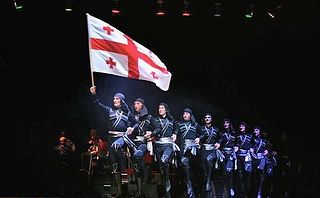
The Khorumi is a war dance that originated in the region of Guria/Adjara, which is located in the southwestern region of Georgia. The dance was originally performed by only a few men. However, over time it has grown in scale. In today's version of the Khorumi, thirty or forty dancers can participate. The dance was inscribed on the Intangible Cultural Heritage of Georgia list in 2013.

Iakob Gogebashvili was a Georgian educator, children’s writer and journalist, considered to be the founder of the scientific pedagogy in Georgia. Through his masterly compiled children's primer, Mother Language, which in a modified form serves to this day as a text book in Georgian schools, every Georgian since 1880 has learnt to read and write in their native language.

A supra is a traditional Georgian feast and a part of Georgian social culture. There are two types of supra: a festive supra, called a keipi, and a sombre supra, called a kelekhi, that is always held after burials.

The Intangible Cultural Properties are aspects of intangible culture that the government of South Korea has officially designated for preservation in accordance with the 1962 Cultural Property Protection Law. They are proclaimed and maintained by South Korea's Cultural Heritage Administration.
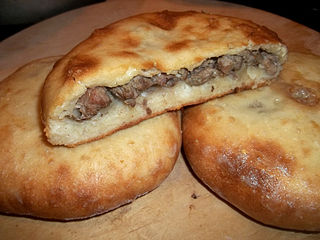
Kubdari or Kubed is a Georgian filled bread dish which is particularly a national dish of the Svans. The bread is leavened and allowed to rise. The filling contains chunks of meat, which can be lamb, kid or pork, Georgian spices and onions. It is also traditionally made with cannabis leaves or cannabis seed paste. Kubdari was inscribed on the Intangible Cultural Heritage of Georgia list in 2015.

Berikaoba is an improvised masqueraded folk theatre in Georgia, stemming from the pagan festivity of fertility and rebirth. The name is derived from a Common Kartvelian root ber (ბერ), meaning "a child". The scenes of Berikaoba range from those of explicitly erotic nature to political satire and social protest.

Laghidze water is a popular Georgian soft drink based on soda and a variety of natural syrups. It has been traditionally mixed in a glass from a soda fountain, but it is also available as a bottled soft drink in a range of flavors. Some American food writers liken it to egg cream, but the authentic Georgian drink includes neither milk nor chocolate syrup.
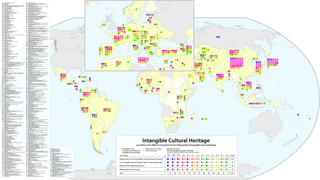
UNESCO established its Lists of Intangible Cultural Heritage with the aim of ensuring better protection of important intangible cultural heritages worldwide and the awareness of their significance. This list is published by the Intergovernmental Committee for the Safeguarding of Intangible Cultural Heritage, the members of which are elected by State Parties meeting in a General Assembly. Through a compendium of the different oral and intangible treasures of humankind worldwide, the programme aims to draw attention to the importance of safeguarding intangible heritage, which UNESCO has identified as an essential component and as a repository of cultural diversity and of creative expression.
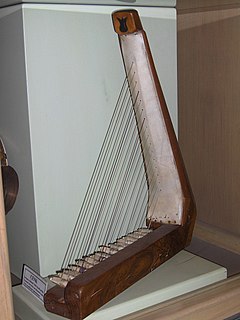
The çeng is a Turkish harp. It was a popular Ottoman instrument until the last quarter of the 17th century.
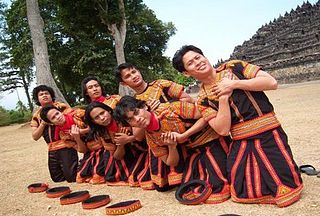
Saman is one of the most popular dances in Indonesia. Its origin is from the Gayo ethnic group from Gayo Lues, Aceh province, Sumatra, and is normally performed to celebrate important occasions. The dance is characterized by its fast-paced rhythm and common harmony between dancers. These two elements are key figures of Saman, and are among the reasons Saman are widely known and practiced in Indonesia, besides being relatively easy to learn.

The Convention for the Safeguarding of the Intangible Cultural Heritage is a UNESCO treaty adopted by the UNESCO General Conference on 17 October 2003. The convention entered into force in 2006, after thirtieth instruments of ratification by UNESCO Member States. As of September 2018, 178 states have ratified, approved or accepted the convention.
Intangible cultural heritage are elements of the cultural heritage of Georgia which are abstract and must be learned, encompassing traditional knowledge including festivals, music, performances, celebrations, handicrafts, and oral traditions.
Mravalzhamieri is a Georgian folk song, the title and the one-word text of which can be translated as "[may you live] a long life". It is a popular and widespread toasting song, with dozens of different versions from the countryside of both eastern and western parts of Georgia. There are also several variants of "urban" Mravalzhamieri, originally from Tbilisi. Mravalzhamieri is typically sung in three-voice polyphony, in which two highly improvised melodic parts are developed on the background of a pedal drone in a free metre. The Mravalzhamieri version from the region of Kakheti and that known as "urban" (k'alak'uri) were inscribed on the Intangible Cultural Heritage of Georgia list in 2013. Mravalzhamieri is also a Georgian name of the Christian chant Polychronion.



















